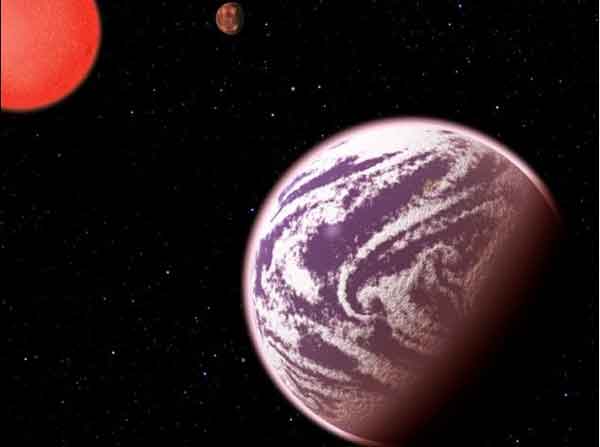 |
|
Earth's gassy twin as been discovered in another solar system 200 light years away. Pictured is an artist's impression of KOI-314c in orbit around its star. It orbits a dim red dwarf star at such a close distance that temperatures on its surface could be as high as 104°C |
|
Scientists believe one in five stars in our galaxy have Earth-like planets orbiting them. But the ultimate goal of finding a world that truly resembles our own has continued to elude astronomers. Now researchers have come a step closer by finding Earth's gassy twin in another solar system 200 light years away. It orbits a dim red dwarf star at such a close distance that temperatures on its surface could be as high as 104°C - too hot for most forms of life on Earth. KOI-314C is only 30 per cent more dense than water. This suggests that the world is enveloped by a blanket of hydrogen and helium hundreds of miles thick. Scientists believe it may have started life as a mini-Neptune before some of its atmospheric gases were blasted away by intense radiation from the parent star. 'This planet might have the same mass as Earth, but it is certainly not Earth-like,' said lead astronomer Dr David Kipping from the Harvard-Smithsonian Centre for Astrophysics. 'It proves that there is no clear dividing line between rocky worlds like Earth and fluffier planets like water worlds or gas giants.' The findings were presented at the annual meeting of the American Astronomical Society in Washington DC. To weigh KOI-314c, the scientists used a new technique called transit timing variations (TTV), which only works when more than one planet orbits a star. The two planets tug on each other, slightly altering the time they take to cross or 'transit' the star's face. Analysing the way the planetary wobbles affect light coming from the star makes it possible to calculate their mass. KOI-314c's companion world is similar to it in size but weighs four times more than the Earth. The new discovery was made by chance as scientists scoured data from the Kepler space telescope looking for evidence of moons rather than planets. 'When we noticed this planet showed transit timing variations, the signature was clearly due to the other planet in the system and not a moon,' said Dr Kipping. 'At first we were disappointed it wasn't a moon, but then we soon realised it was an extraordinary measurement.' |
据英国《每日邮报》报道,科学家发现在距离地球200光年的地方有一颗与地球质量相同的神秘行星。 尽管科学家认为在银河系中五分之一的恒星都有一个与地球相似的行星围绕其运行,但是天文学家们却从未找到另外一个与地球真正相似的世界。 不过,研究者们最近离这一目标又近了一步,在距离地球200光年的外星系中发现了地球的“双胞胎”。 这颗被称为“KOI-314c”的行星,质量与地球相当,但是体积比地球大60%。科学家怀疑这是因为它的大气层更厚。 这颗行星围绕一颗暗红色的小行星近距离运行,因此其表面温度高达104摄氏度,这个温度对于地球上的大部分生物来说都太高。 行星”KOI-314C“的密度只比水高30%。这意味着它被厚达几百英里的氢气和氦气像毯子一样包裹着。但是科学家认为,在其大气受到来自恒星的强辐射而爆炸之前,这颗行星可能已经像一颗迷你海王星那样运行。 哈佛大学史密森尼天体物理学中心的David Kipping博士则认为:“这颗行星可能只是与地球质量相同,但肯定不是与地球相似的行星。” 此前,科学家试图从开普勒太空望远镜的数据中寻找与地球相似的卫星,而这颗行星是机缘巧合下的新发现。 相关阅读 (莫竞西 编辑:信莲)
|
|
|
